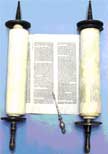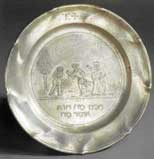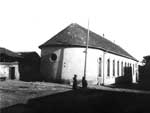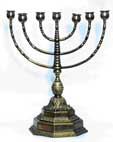|
Before we acquaint ourselves with a number of basic, characteristic sites and tokens of the Jewish cultural heritage in Belgrade we must first acquaint ourselves with the Jews themselves.
|
Jews belong to a Semitic group of peoples and stem from the region of near Asia (approximately today’s territory of Israel), where they settled and lived on from the II millennia B.C. up to the beginning of the 2nd century when they definitely dispersed all round the world in large numbers. The ancient Jews spoke Hebrew and Aramaic languages (the language of the people), and their religion Judaism was a monotheistic religion from the onset, contrary to polytheistic religions of the Ancient world.
The entire history of the Jewish people has been marked by an endless Diaspora, which was additionally pronounced at the time of occupation or better said inclusion into the enormous Roman Empire (year 63 B.C. and later on).
|

Torah and grief, from the collection of the Jewish Historical Museum, Belgrade
|
Wars and claiming of territories dating from the Ancient period, resulted in great and long-term population migrations of the ancient world which left deep traces and concrete consequences in the ensuing historical, cultural and demographic course of events affecting the Jewish nation. The history of the Jews which now adds up to approx. 4000 years naturally abounds with numerous historical events which conditioned life itself in all its myriad aspects. It was a fertile basis for building legends, culture, beliefs, an entire thinking process and mode of functioning of one distinct nation …and on which same basis a unique, complex, resilient system of customs was already formed long ago.
|
|
Relocation throughout the Roman provinces meant migration to various European countries. Throughout the centuries, two major demographic entities became distinctive: the Pyrenean peninsula Sephardim i.e. Spanish and Portuguese Jews. The resettlement of this group of Jews lasted over a period of one thousand years. The other entity was the Ashkenazi - Central and Eastern Europe Jews. Life in different geographic, historical and cultural environments inevitably conditioned the emergence of custom specifics, as well as major language differences, language being one the most important if not the most important distinction of a nation. The power of language is great; the language of one’s choice can either bring people together or act as an obstacle between them. The Sephardim Jews spoke Ladino or Judeo-Espanola, while the Ashkenazi spoke Yiddish. Although structured in form, both languages were amalgams of various language elements which were based on Spanish in the first case and on German in the second.
|

The Pesah Plate, from the collection of the Jewish Historical Museum, Belgrade
|
|
However, despite the inevitable occurrence of unavoidable objective differences between the Sephardim and Ashkenazi ethnic-image, ties to the source culture and religion founded in the land of origin remained intact. This persistent observation of the religious-national epitome, together with the rituals and customs that have continually sustained it, is paramount to understanding the Jewish nation.
|
|
Both the Sephardim and Ashkenazi migrated to and settled in Serbia. The Sephardim came in the wake of the Catholic Inquisition exodus from Spain in 1492 i.e. from Portugal in 1498. They arrived in large numbers in Belgrade and south of Belgrade, to the part of Serbia that was at the time under Turkish Imperial rule. Certain data indicates the presumption that the Sephardim community was founded in Belgrade in the twenties of the 16th century. The bulk of the Jewish Sephardim populace concentrated in Dorcol which became known as the Jewish mahala (neighborhood).
|

Megilat Ester, from the collection of the Jewish Historical Museum, Belgrade
|
Contrary to the Sephardim who mainly arrived in a single migratory wave, the Ashkenazi came in small groups throughout the entire Middle age, while their relocation gained in intensity during the 18th and 19th century. Actually, they fled to our country from Central and East Europe escaping various banishments, even pogroms. They mainly settled in Vojvodina founding many small communities but were also present in other parts of Serbia. At the time of Sephardim settlement, the Ashkenazi already had their community in Belgrade and were partly concentrated on the river Sava slope and embankment, actually on the other side of Dorcol situated on the Danube embankment. Beside the two stated Belgrade town cores of Judaism there were many Sephardim and Ashkenazi families living in other parts of Belgrade. According to more recent data it is estimated that by WWII there were almost 39.000 Jews living in the territory of Serbia out of which some 10 – 20.000 in Belgrade alone.
|
|
Once there stood a synagogue in Dorcol which was most probably built in the 17th century (there is no precise data). It was in Visokog Stevana Street. The old and rundown edifice of the synagogue was torn down in 1952. Today, this site still belongs to the Belgrade Jewish Community with only the remains of the synagogue foundation still visible on it. However, from times bygone to this day there remains in Dorcol the Building of the Jewish Women’s Society also in Visokog Stevana Street No.2. and can still be visited. The Jewish Women’s Society was founded in Belgrade in 1874 and was recognized as a prominent humanitarian organization of Jewish women.
|

The old Synagogue in Dorcol, archive of the Jewish Historical Museum, Belgrade
|
This building was erected in 1938 and inside it was the safe-house for children and later on a kindergarten; during 1941 it functioned as the Jewish hospital right up to the German pogrom of the Belgrade Jewish population.
The main street in Dorcol is Jevrejska ulica (Jewish Street). In this street the building No.16 is the Oneg Sabat built by the religious and humanitarian society Oneg Sabat and Gemilut Hasadim in 1923. The designer was architect Samuel Sumbul. From 1926 part of the building was used as the Jewish home for the elderly although various social events took place there so that it also had a wider social and cultural purpose.
Outside the Dorcol quarter in Cara Urosa Street stood a large Sephardim synagogue Bet Jisrael. The synagogue was demolished during bombardments of Belgrade in WWII. On the ruins of its foundation the Gallery of Frescoes, a department of the Belgrade National Museum was built. Beside the entrance to the Gallery a plaque dedicated to the former synagogue was placed. The construction of Bet Jisrael began ceremoniously in 1907 when King Petar I laid down the foundation stone. The building was erected in one year and in keeping with to the exceptional design of architect Milan Kapetanovic. It was supervised by Viktor Azriel.
|
|
In the immediate neighborhood of the Bet Jisrael synagogue is the site of the exquisite edifice of the Belgrade Jewish community in No.71 Kralja Petra Street. The design for this building was made by Samuel Simbul in 1928 for the requirements of the contemporary Religious-educational community of the Sephardim congregation (as it was known at the time). The premises of the Association of Jewish communities of Serbia are located inside the building of the Belgrade Jewish community with the Association’ affiliate, the Jewish Historical Museum situated on its first floor. The Jewish Historical Museum was founded in 1948 and is the only museum of this type in Serbia. It is specific by its themes and very complex in content. The museum has a permanent display of artistic, historical, cultural-historical and ethnic artifacts, and a collection judaike as well as its own archive with material and documents approx. 1000 meters in length.
|

The building of the Jewish community in Belgrade
|
Up to now the Jewish Historical Museum has staged 50 exhibitions mostly of academic character and has published a number of theme books, catalogues, specialist and commemorative books and editions. The internet address of our Museum is: www.jimbeograd.org
The Ashkenazi synagogue is located on the previously mentioned Sava slope and embankment in No.19 Marsala Berjuzova Street. King Alexander Karadjordjevic laid the founding stone at the ceremony of construction commencement in 1924. The building was completed in 1925 but the name of the architect has been lost. During WWII the synagogue had a sad and somewhat strange destiny; the Germans used it as a warehouse and brothel. Upon the war the building was consecrated and returned to its initial purpose. Today it regularly performs its original function.
|

Mehorah, from the collection of the Jewish Historical Museum, Beograd
|
Cemeteries are also part of the cultural and historical heritage of a nation. The Jewish Sephardim cemetery is located in another part of the city, in Ruzveltova Street. The cemetery burial ground was bought by the Jewish community in the 19th century and the cemetery founded in 1888. The cemetery is still in function. Beside individual memorial headstones there is a geniza in the cemetery. The geniza is a tomb where Jewish religious books are buried. In the cemetery there are also three distinctive monuments:
the monument to Jewish soldiers of the Balkan wars and the First World War 1912-1918 erected according to Samuel Sumbul design on the so called “warrior burial ground” and revealed in 1927 in the presence of state and royal representatives;
the monument to Jews victims of WWII erected in 1952 an original sculpture by the artist Bogdan Bogdanovic;
the monument to Jewish refugees from Austria (Kladovo Transport, 1939) erected by the Vienna Jewish community in 1959 according to the design of Anri Meshulam.
The Ashkenazi cemetery is located across the street from the Sephardim cemetery. It has ceased to function a long time ago, although it can still be visited. The Ashkenazi cemetery was erected when the Administration of the city’s New cemetery established in 1876 provided a separate burial ground for worshippers of different faith.
Beside the above mentioned memorial to Jewish martyrs of WWII in the Sephardim Jewish cemetery there exist in the territory of Belgrade many other memorial sites and monuments dedicated to victims of the Holocaust. Two of the more recently erected ones are: the sculpture Menorah in flames by the artist Nandor Glida placed on the Danube embankment (bringing us back to Dorcol again) and the monument to the victims of the German death camp Sajmiste (Fair), a sculpture by the artist Misa Popovic positioned on the embankment of the river Sava.
This text contains only brief outlines of Belgrade’s Jewish cultural heritage. This heritage is much greater and its entity is significantly present both in Belgrade and throughout Serbia.
Vojislava Radovanović, ethnologist,
Director of the Jewish Historical Museum in Belgrade
|